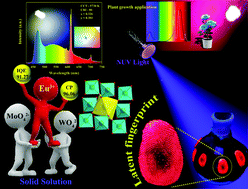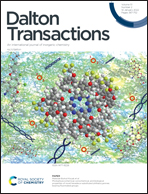Efficient and ultra-thermally stable Eu3+ and Sm3+-activated narrow-band red/deep red-emitting phosphors and their versatile applications†
Abstract
A succession of Eu3+-activated Na2Y4(WO4)7 (NYW) red phosphors were synthesised and their optical properties were studied in detail for white LED, latent fingerprint and plant growth applications. The phosphors crystallised in a tetragonal system with space group I41/a. The NYW:Eu3+ red phosphors demonstrated a line-like emission at 616 nm owing to electric dipole transition, and a systematic concentration-dependent PL study revealed that concentration quenching occurs at x = 1.8 with a color purity of 96.06%. The thermal stability and internal quantum efficiency of the phosphor were found to be ∼75.54% (at 423 K) and 88%, respectively. Furthermore, solid solution phosphors were synthesized to increase QE, which was found to be 91.27%. Specifically, the hybrid white LED exhibits warm white light with high CRI (80) and low CCT (5730 K) values, and these values are further improved (CRI-81, CCT-4274 K) when the WLED is fabricated using the most efficient solid solution phosphor Na2Y2.2Eu1.8(WO4)3(MoO4)4. The currently synthesized phosphors can be potential candidates for security applications. The selected phosphor compositions can be used for the detection of latent fingerprints. Besides, a succession of Eu3+ and Sm3+ co-doped phosphors were synthesized and their photophysical properties were studied systematically. The deep red LED was fabricated using the same and this could be a possible light source for plant growth usage.



 Please wait while we load your content...
Please wait while we load your content...